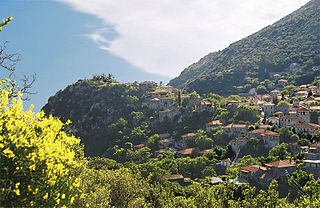| Look up Macaria in Wiktionary, the free dictionary. |
Macaria is the name of two figures from ancient Greek religion and mythology.
Contents
Macaria may also refer to:
| Look up Macaria in Wiktionary, the free dictionary. |
Macaria is the name of two figures from ancient Greek religion and mythology.
Macaria may also refer to:
| This disambiguation page lists articles associated with the title Macaria. If an internal link led you here, you may wish to change the link to point directly to the intended article. |

Arcadia is one of the regional units of Greece. It is part of the administrative region of Peloponnese. It is situated in the central and eastern part of the Peloponnese peninsula. It takes its name from the mythological figure Arcas. In Greek mythology, it was the home of the god Pan. In European Renaissance arts, Arcadia was celebrated as an unspoiled, harmonious wilderness.
In Greek mythology, Macar or Macareus or Macareas, is the name of several individuals:
Macaria or Makaria is the name of two figures from ancient Greek religion and mythology. Although they are not said to be the same and are given different fathers, they are discussed together in a single entry both in the 10th-century Byzantine encyclopedia the Suda and by Zenobius.

Elis or Eleia is an ancient district that corresponds to the modern regional unit of Elis.
Malea may refer to:

Gortyna, is a former municipality in Arcadia, Peloponnese, Greece. Since the 2011 local government reform it is part of the municipality Megalopoli, of which it is a municipal unit. The municipal unit has an area of 116.205 km2. Its seat was in the village Karytaina. The name of the municipality was taken from the ancient city of Gortys.

Arcadia was a region in the central Peloponnese. It took its name from the mythological character Arcas and in Greek mythology, it was the home of the god Pan. In European Renaissance arts, Arcadia was celebrated as an unspoiled, harmonious wilderness; as such, it was referenced in popular culture.

Stemnitsa is a mountain village in the municipal unit of Trikolonoi, Arcadia, Peloponnese, Greece. It was the seat of the former municipality Trikolonoi. Stemnitsa is a traditional settlement and is considered one of the most beautiful villages in Arcadia, due to its picturesque location and its historical churches and mansions. It is situated at the western edge of the Mainalo mountains, above the left bank of the river Lousios, at about 1050 m elevation. Stemnitsa is 6 km southeast of Dimitsana, 9 km northeast of Karytaina, 18 km northwest of Megalopoli and 26 km west of Tripoli. In 2011 Stemnitsa had a population of 191.

Thoknia is a village in the municipality of Megalopoli, Arcadia, Greece. It is situated near the confluence of the rivers Alfeios and Elissonas, at about 360 m elevation. It was named after the ancient Arcadian city Thocnia, that was located in the area. Thoknia is 2 km east of Kato Karyes, 3 km southeast of Kyparissia, 3 km southwest of Plaka and 5 km northwest of Megalopoli. Thoknia had a population of 36 in 2011. The village is surrounded by open-pit lignite mines.
Theisoa may refer to:
The Lampads or Lampades are the nymphs of the Underworld in Greek mythology.

Macaria alternata, the sharp-angled peacock, is a moth of the family Geometridae. It is found in Europe, Turkey, the Caucasus, Georgia and South Siberia.

Methydrio is a village in the municipal unit of Vytina, Arcadia, Greece. In 2011, it had a population of 11. It sits at 1,060 m above sea level, at the foot of the Mainalo mountains. It is 4 km south of Vytina. It was named after the ancient city Methydrium, the remains of which have been discovered near the village.

Macaria signaria, the dusky peacock, pale-marked angle or spruce-fir looper, is a moth of the family Geometridae. The species was first described by Jacob Hübner in 1809. Subspecies Semiothisa signaria signaria is found in Europe, Turkey, the Caucasus, Transcaucasia, the Ural, Siberia, Far East, Sakhalin, northern Iran and Japan. Subspecies Macaria signaria dispuncta is found in North America.
Phylace or Phylake may refer to:

Macaria is a genus of moths in the family Geometridae first described by John Curtis in 1826. It is sometimes placed as a synonym of Semiothisa. Species are cosmopolitan.

The regions of ancient Greece were areas identified by the ancient Greeks as geographical sub-divisions of the Hellenic world. These regions are described in the works of ancient historians and geographers, and in the legends and myths of the ancient Greeks.

Macaria artesiaria is a moth of the family Geometridae. It is found from the North Sea to Mongolia and the Amur River.

Macaria aequiferaria, the woody angle moth, is a moth of the family Geometridae. The species was first described by Francis Walker in 1861. It is found in North America, where it has been recorded from Maryland, and Delaware to Florida, west to Texas, as well as in Oklahoma, Mississippi, Kentucky and southern Illinois. It is also found in Mexico.
Macareae or Makareai, also known as Macaria or Makaria (Μακαρία), was a town of ancient Arcadia, in the district Parrhasia, 22 stadia from Megalopolis, on the road to Phigaleia, and 2 stadia from the Alpheius. It was in ruins in the time of Pausanias, as its inhabitants had been removed to Megalopolis upon the foundation of the latter (371 BCE). According to Greek mythology, it was founded by Macareus, a son of Lycaon.